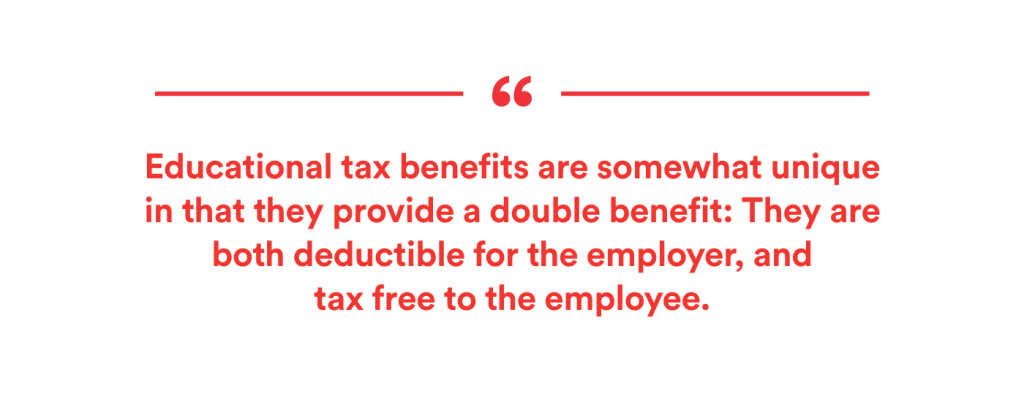
This piece has been adapted from Talent Economy. Read General Assembly and Whiteboard Advisors’ full white paper, Investing in Talent, here (PDF).
Amid complex external and economic pressures, companies must face the reality that the nature of business is changing. The pace of technological change continues to accelerate, and in an era in which the shelf life of skills is less than five years, it is critical for employers to prepare their workers to adapt to the shifting demands of work in the digital age.
The good news for employers is that current federal policy provides tax-advantaged opportunities for companies to support employees’ educational aspirations. Rooted in sections 117, 127, and 132 of the tax code, educational tax benefits are somewhat unique in that they provide a double benefit: They are both deductible for the employer, and tax free to the employee.
Studies indicate that participation in tuition reimbursement programs can reduce employee churn, and a growing number of savvy employers have turned to educational assistance to combat employee turnover. “Estimates suggest that the cost of replacing a worker is somewhere between 16% and 20% of the employee’s annual salary, which means that education, in many cases, costs less than churn — and companies can generate positive return on tuition assistance in a relatively short timeframe,” according to Rachel Carlson, CEO and co-founder of Guild Education.

However, business leaders are often unclear where federal policy ends — and corporate norms begin — when it comes to the rules that govern the administration of education benefits. Too often, corporate policies are antiquated, reflecting an outdated and limited view of the landscape of educational options.
“There tends to be confusion about inclusion of nontraditional providers in educational assistance programs,” says Charlie Schilling, general manager, enterprise at General Assembly. “Employers believe they are limited to only degree-granting or accredited institutions, when, in reality, there is substantially more flexibility in the tax code.”
The resultant confusion, in some cases, appears to limit innovation — and options — as employees and executives alike clamor for more flexible benefits and experiment with a multiplicity of new education providers.
With the president’s tax plan out this week and talk of comprehensive tax reform taking over inside the Beltway, it is useful to understand current tax code provisions — particularly since one person’s tax loophole is another’s tax incentive. Here’s a breakdown of how companies can leverage the tax code to support employees’ educational aspirations in ways that help to attract and retain talent.
Section 127
Initially added as a five-year provision to the tax code in 1978, Section 127 allows employers to provide up to $5,250 per year, per employee in tax-exempt tuition benefits to cover the cost of tuition, fees, and books. Benefits under IRC Section 127 benefit both the employer and employee: they are generally excluded from the employee’s income for purposes of federal income tax, and employers may be able to claim a business deduction on the benefits.
While Section 127 benefits have been limited to accredited institutions at various points in history, today, educational assistance programs under Section 127 can cover a broader array of opportunities, including graduate education and non-degree-seeking educational experiences.
Throughout the 1980s and ’90s, the tax treatment of employer-provided education benefits under Section 127 remained a moving target. The provision was extended nine times before being made permanent in 2013. Yet while the provision was made permanent four years ago, the amount — $5,250 — has not changed since 1986. Indexed to inflation, this benefit would be worth over $11,500 today. This cap has also not kept up with the rising cost of college: In 1986, $5,250 would cover total tuition, room, and board at most four-year institutions; today, the benefit would cover only about 50% of the average yearly in-state tuition and fees at a public four-year institution.
Employers offering assistance under Section 127 must codify their plan in a formal written document and submit it to the IRS, indicating that the plan does not discriminate in favor of highly compensated employees, and that eligible employees receive information about the program. Employers must not give employees a choice between benefits under the program and taxable compensation (e.g. higher salary/cash).

Section 117
Like Section 127, Section 117 requires a formal written plan each year, and requires that employers provide reasonable notice to employees. Unlike Section 127, however, Section 117 requires that employees be enrolled in degree-granting institutions in order to receive scholarships. Additionally, the scholarships cannot fund education that materially benefits the employer. So, for example, an employer cannot give a scholarship under Section 117 to an employee in order for that employee to seek advanced training that will improve the employee’s ability to do his or her job.
This provision makes the use of Section 117 hard for most employers, as nearly any further education could potentially help an employee improve his or her performance. In fact, the IRS found that its own scholarship program actually fell short of meeting the requirements of this section.
Section 132
Section 132 has fewer administrative requirements, but is the strictest about job relevance, requiring that every course be evaluated individually to determine whether it is eligible to be tax exempt. Coursework under Section 132 must be either legally required in order for the employee to keep his or her present salary, status, or job, or must help an employee maintain skills required for his or her current employment. This section is not intended to support coursework that prepares an individual for a new job. Unlike Section 127, benefits provided under Section 132 do not have an annual limit.
Other sections of the Internal Revenue Code provide opportunities for individuals to claim tax benefits for educational expenses. If tuition exceeds the amount covered by an employer’s tuition assistance program, individuals paying the remainder out of pocket may be able to take advantage of tax credits or deductions.
Because of these requirements, educational assistance programs can become challenging for companies to administer without the help of outside expertise, depending on how many eligible employees decide to take advantage of the plan.
For a more detailed look at the who, what, where, how, and why of employee tuition assistance, download Investing in Talent: A Policy Primer and Perspectives on Employer-Provided Educational Assistance (PDF), a white paper authored by Whiteboard Advisors, in partnership with General Assembly.
***
ABOUT GENERAL ASSEMBLY
General Assembly (GA) is a global educational company on a mission to empower individuals and professional communities to pursue work they love. Focusing on the most relevant and in-demand skills across data, design, business, and technology, GA confronts the skills gap through best-in-class instruction and career-growth opportunities. GA works with students online and in person at more than 20 campuses in six countries. GA also collaborates with employers to help companies source, assess, and transform talent. Additionally, GA’s focus on affordable and accessible education — combined with our education-to-employment approach — is helping to foster a diverse talent pipeline.
ABOUT WHITEBOARD ADVISORS
Whiteboard Advisors advises the most transformative businesses and organizations in education, health, and wellness. Our team of policy wonks, geeks, and storytellers brings an unmatched understanding of the political and policy landscape to bear on strategy. With offices in Washington, D.C., and Silicon Valley, we help our clients navigate complex regulatory issues, conduct policy and market research, and implement creative communications strategies.
Over 45% of General Assembly’s part-time students receive tuition reimbursement through their employers. At GA, explore innovative, career-building courses in web development, design, data, marketing, and business — online and at campuses across the globe. Assess job candidates and your employees’ skills through GA’s Credentials division, and find out how you can invest in your employees’ skills and growth through our corporate training programs.